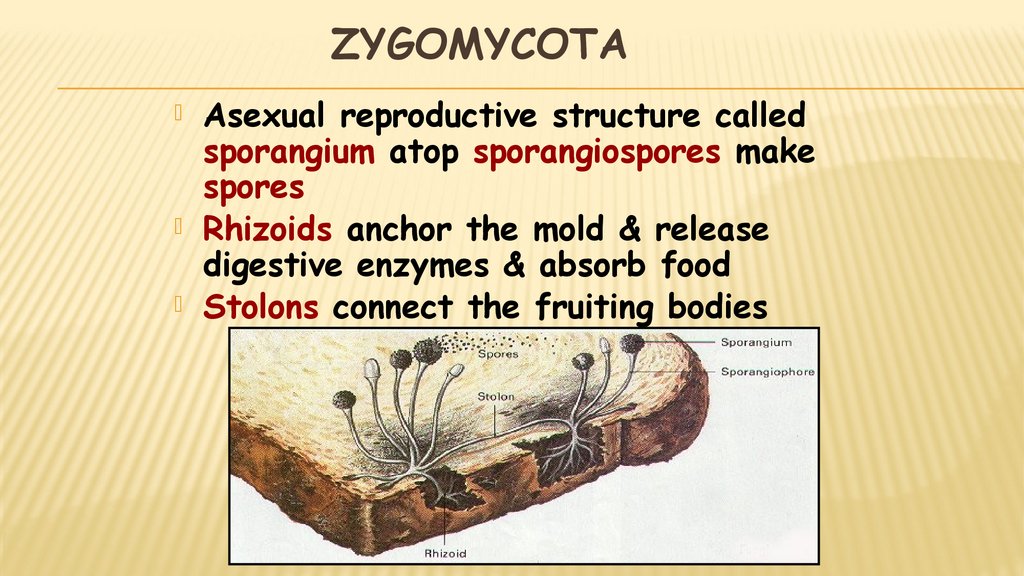Similar presentations:
Eukaryotic microorganisms. Fungi
1. Eukaryotic microorganisms. Fungi
2. The Characteristics of Fungi
THE CHARACTERISTICS OF FUNGICell walls are made of chitin
(complex polysaccharide)
Body is called the Thallus
Grow as microscopic tubes
or filaments called hyphae
2
3. The Characteristics of Fungi
THE CHARACTERISTICS OF FUNGIGrow best in warm, moist
environments
Mycology is the study of fungi
Mycologists study fungi
A fungicide is a chemical used to
kill fungi
Fungicide
kills leaf
fungus
3
4. The Characteristics of Fungi
THE CHARACTERISTICS OF FUNGIImportant decomposers
& recyclers of nutrients
in the environment
Most are multicellular,
except unicellular yeast
Lack true roots, stems
or leaves
MULTICELLULAR
MUSHROOM
UNICELLULAR YEAST
4
5.
6. Spores and More Spores
• Fungi are prolific spore producers• Spores can be sexual, asexual, or both
Nail Fungus
Hyphae with
spores attached
7. The Characteristics of Fungi
THE CHARACTERISTICS OF FUNGIFungi include
puffballs, yeasts,
mushrooms,
toadstools, rusts,
smuts, ringworm, and
molds
The antibiotic
penicillin is made by
the Penicillium mold
Penicillium mold
Puffball
7
8. SEXUAL REPRODUCTION
Haploid 1n hyphae from 2 mating types(+ and -) FUSE (Fertilization)
Forms a hyphae with 2 nuclei that
becomes a ZYGOTE
The zygote divides to make a SPORE
+
SPORE FORMS
8
9. ASEXUAL REPRODUCTION
Fruiting Bodies are modified hyphaethat make asexual spores
An upright stalk called the
Sporangiosphore supports the spore
case or Sporangium
9
10. It’s All About the Spores!
IT’S ALL ABOUT THE SPORES!Fungi are classified by their
REPRODUCTIVE STRUCTURES and
SPORES
The reproductive structures are:
BASIDIA - BASIDIOMYCOTA
SPORANGIA - ZYGOSPORANGIA
ASCUS - ASCOMYCOTA
10
11. ASEXUAL REPRODUCTION
Types ofFruiting Bodies:
Basidia
Sporangia
Ascus
Sporangia
Basidia
11
12.
Each spore that germinates can be the start ofa hypha and a mycelium. Stalked
reproductive structures (sporangia) may
develop on many of the hyphae and produce
asexual spores. After the spores germinate,
each may be the start of still another
extensive mycelium.
13. Classification by Nutrition
SaprobesParasites
Decomposers
Molds, mushrooms, etc.
Harm host
Rusts and smuts (attack plants)
Mutualists
Both benefit
Lichens
Mycorrhizas
13
14. Fungal Lifestyles
Mutualists: Mycorrhizae15. Fungal Lifestyles
Parasites16. Fungal Lifestyles
Predators17. Fungal Lifestyles
Mutualists: LichensPhoto Credit: Field Biology Student, 360 Overlook 2005
18. Fungal Lifestyles
Saprobes = Decomposers19. Major Groups of Fungi
MAJOR GROUPS OF FUNGIBasidiomycota – Club Fungi
Zygomycota – Bread Molds
Chytridiomycota – Chytrids
AM Fungi - Mycorrhizas
Ascomycota – Sac Fungi
Lichens – Symbiosis (algae & Fungi)
20. ZYGOmycota
ZYGOMYCOTA20
21. Zygomycota
ZYGOMYCOTACalled the sporangium
fungi
Commonly called molds
Also includes blights
Hyphae have no cross
walls (aseptate)
Grow rapidly
Includes bread mold
Rhizopus stolonifer
Rhizopus on strawberries
Tomato Blight
22. Zygomycota
ZYGOMYCOTAAsexual reproductive structure called
sporangium atop sporangiospores make
spores
Rhizoids anchor the mold & release
digestive enzymes & absorb food
Stolons connect the fruiting bodies
23. USES For Basidiomycota
USES FOR BASIDIOMYCOTASome are used as
food (mushrooms)
Others damage
crops (rusts &
smuts)
Corn Smut
Portobello Mushrooms
Soybean
Rust
24. Ascomycota
ASCOMYCOTA24
25. Characteristics
CHARACTERISTICSCalled Sac fungi
Includes Cup fungi, morels, truffles,
yeasts, and mildew
May be plant parasites (Dutch elm
disease and Chestnut blight)
Reproduce sexually & asexually
Ascus - sac that makes ascospores in
sexual reproduction
Specialized hyphae known as Ascocarps
contain the asci
26. Yeasts Budding
YEASTS BUDDINGSaccharomyces
27. Uses of Ascomycetes
USES OF ASCOMYCETESTruffles and morels are
good examples of edible
ascomycetes
Penicillium mold makes
the antibiotic penicillin.
Some ascomycetes also
gives flavor to certain
cheeses.
Saccharomyces
cerevesiae (yeast) is used
to make bread rise and
to ferment beer & wine.
28. Basidiomycota
BASIDIOMYCOTACalled Club fungi
Includes:
Mushrooms
Toadstools
Bracket & Shelf fungi
Puffballs
Stinkhorns
Rusts and smuts
29. USES For Basidiomycota
USES FOR BASIDIOMYCOTASome are used as
food (mushrooms)
Others damage
crops (rusts &
smuts)
Corn Smut
Portobello Mushrooms
Soybean
Rust






























 biology
biology








